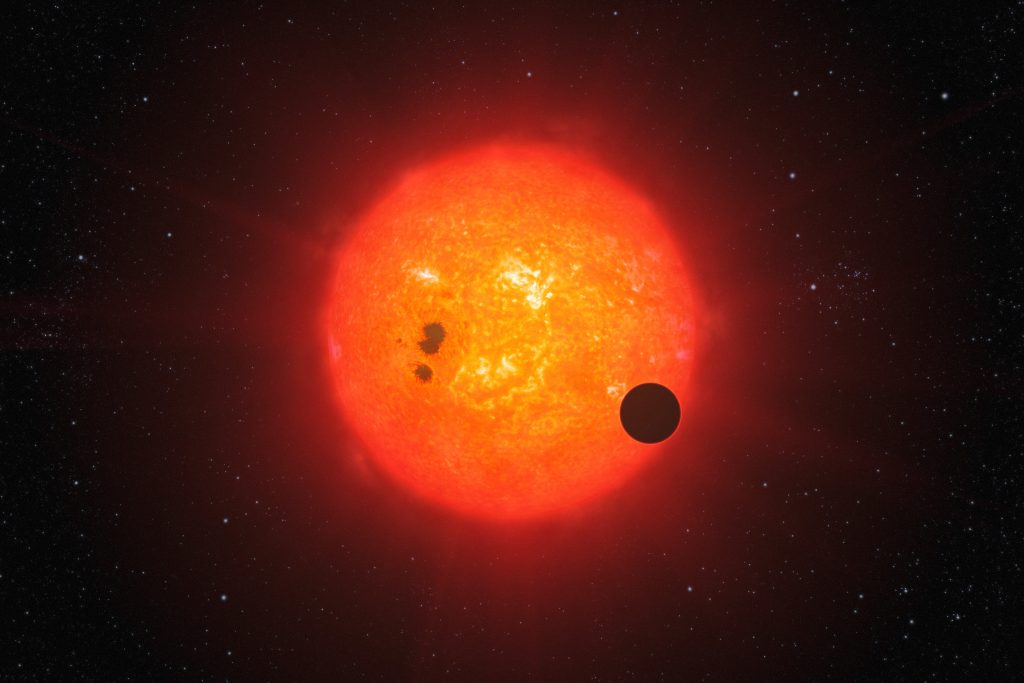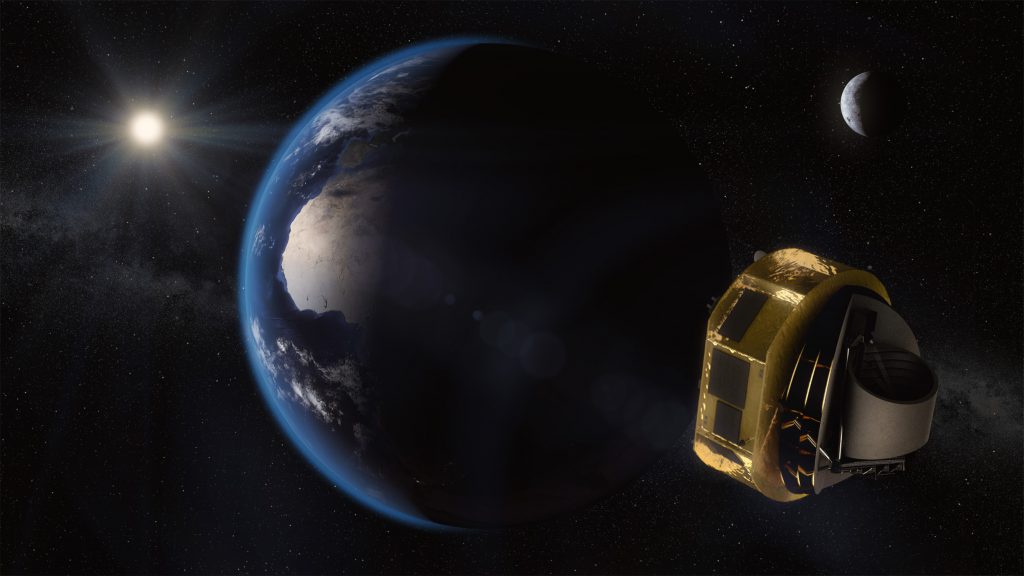ARIEL exoplanet mission celebrates machine learning challenge and citizen science launch
ARIEL, an ESA mission to make the first large-scale survey of exoplanet atmospheres, has announced the winners of its first international Machine Learning Data Challenge and has launched a new project, ExoClocks, aimed at amateur astronomers and citizen scientists.
The winners of the Data Challenge, James Dawson (Team SpaceMeerkat), and Vadim Borisov (Team major_tom), were announced today at the EPSC-DPS Joint Meeting 2019 in Geneva. The pair topped the leader-board for the competition out of 112 registered individuals and teams. The Data Challenge, launched in April, tackled the problem of removing noise from exoplanet observations caused by starspots and by instrumentation.
Nikos Nikolaou of the UCL Centre for Exochemistry Data, who devised the competition, said, “The outcomes of the competition exceeded our expectations, both in terms of the quality of the technical solutions submitted and in the massive numbers of entries for the challenge, which rivalled participation in open machine learning competitions with large monetary prizes.”
A dedicated session is being held today at EPSC-DPS 2019 to present the methodologies used by the winning teams to the exoplanet research community, in order to share advancements in computational statistics and machine learning. The five top-ranked teams have additionally been invited to present their solutions at the European Conference on Machine Learning (ECML-PKDD 2019) on Friday. The participation in both conferences aims to develop closer collaborations between exoplanet researchers and the machine learning and statistics communities.
ARIEL has also launched the ‘ExoClock’ project to collect measurements known as ‘light curves’ that show the drop in intensity as a planet transits in front of its host star and blocks some of the light. When ARIEL starts its mission to observe 1000 exoplanets in 2028, it will need to have precise knowledge of the expected transit time of each planet that it observes. Transits can be measured using small and medium-scale telescopes and give key information about the exoplanets, including their size, orbit, mass and density. ExoClock aims to enlist the sizeable and active amateur astronomy community around the world to gather large numbers of light curve observations and improve the accuracy of transit timings.
“This is the first open call to join the ExoClock project and we encourage all interested observers to become part of ESA’s ARIEL mission. Every transit observation is unique and important. By participating in ExoClock, citizens all over the world can contribute to the success of the ARIEL mission,” said Anastasia Kokori, who announced the launch of ExoClock at EPSC-DPS 2019.
The ExoClock platform includes target prioritisation and an alert systemto maximise coverage of exoplanet targets and efficient use of resources. Users are given a personalised schedule based on their telescopes and their geographical location. The lightcurves submitted will be analysed, published and credited on ExoClock website and may become part of scientific publications.
Experienced observers can register directly at exoclock.spaceand get started. For observers that are new to exoplanet transits, training is provided through the ExoWorlds Spies project (exoworldsspies.com). All online resources are currently available free of charge in English and in Greek.
Giovanna Tinetti, Principal Investigator for the ARIEL mission, said: “ARIEL is a challenging mission that’s pushing the boundaries of exoplanet research. The Data Challenges and ExoClock project are enabling us to build a global community of collaborators with a diverse mix of skills and backgrounds. We look forward to working with them over the next few years to develop networks, tools and analysis techniques in preparation for the mission’s launch in 2028.”
Animation
Exoplanet Animation – Transit Light Curve
When a planet crosses directly between us and its star, we see the star dim slightly because the planet is blocking out a portion of the light. We can make a plot called a light curve with the brightness of the star versus time. Using this plot, we can see what percentage of the star’s light the planet blocks and how long it takes the planet to cross the disk of the star. Larger planets block out more light. Credit: NASA/Goddard Media Studios.
Images
Star spots: Space mission data analysis is not easy, especially if you need to observe a planet passing in front of its star that is often 100s of lightyears away. At such distance, one of the main issues is differentiating what is planet and what is star. The Machine Learning ARIEL Data Challenge tackled the problem of identifying and correcting for the effects of spots on the star from the faint signals of the exoplanets’ atmospheres. This image shows a transiting planet passing in front of a star with stellar spots. Credit: ESO/L. Calçada

ARIEL: Artist’s impression of ARIEL on its way to Lagrange Point 2 (L2). Here, the spacecraft is shielded from the Sun and has a clear view of the whole sky. Image Credit: ARIEL space mission/Science Office.

Science Contacts
Nikos Nikolaou
UCL Centre for Space Exochemistry Data
n.nikolaou@ucl.ac.uk
Anastasia Kokori
ExoClock project
UCL Centre for Space Exochemistry Data
anastasia.kokori@gmail.com
Media Contacts
Anita Heward
EPSC Press Officer
+44 7756 034243
epsc-dps-press@europlanet-society.org
Livia Giacomini
EPSC Press Officer
epsc-dps-press@europlanet-society.org
Adriana Postiglione
EPSC Press Officer
epsc-dps-press@europlanet-society.org
Notes for Editors
ARIEL (Atmospheric Remote-sensing Infrared Exoplanet Large-survey)
ARIEL, a mission to answer fundamental questions about how planetary systems form and evolve, is a European Space Agency (ESA) medium-class science mission due for launch in 2028. During a 4-year mission, ARIEL will observe 1000 planets orbiting distant stars and make the first large-scale survey of the chemistry of exoplanet atmospheres. The ARIEL mission has been developed by a consortium of more than 60 institutes from 17 ESA member state countries, including UK, France, Italy, Poland, Spain, the Netherlands, Belgium, Austria, Denmark, Ireland, Hungary, Sweden, Czech Republic, Germany, Portugal, Norway and Estonia with an additional contribution from NASA in the USA currently under study. The UK ARIEL team at UCL, STFC RAL Space, Cardiff University, Oxford University, Mullard Space Science Laboratory, STFC RAL Technology Department and UK ATC is supported by the UK Space Agency. https://ariel-spacemission.eu/
EPSC-DPS Joint Meeting 2019
The 2019 Joint Meeting (www.epsc-dps2019.eu) of the European Planetary Science Congress (EPSC) of the Europlanet Society and the Division for Planetary Sciences (DPS) of the American Astronomical Society (AAS) will take place at the Centre International de Conférences de Genève (CICG), Geneva, Switzerland, from Sunday 15 to Friday 20 September 2019. More than 1950 abstracts have been submitted and over 1500 planetary scientists from Europe, the US and around the world are expected to attend the meeting, making it one of the largest gatherings of planetary scientists held in Europe to date.
The EPSC-DPS Joint Meeting 2019 will be the third time that EPSC and the DPS Annual Meeting have been held together.
Follow: @europlanetmedia#EPSCDPS2019
Europlanet
The Europlanet Society, launched in September 2018, is an organization for individual and corporate members to promote the advancement of planetary science and related fields in Europe. The Society provides Europe’s planetary science community with a platform to exchange ideas and personnel, share research tools, data and facilities, define key science goals for the future, and engage stakeholders, policy makers and European citizens with planetary science. The Europlanet Society is the parent organisation of the European Planetary Science Congress (EPSC).
Europlanet Society website: www.europlanet-society.org
EPSC-DPSC 2019 Joint Meeting 2019 website: www.epsc-dps2019.eu
DPS
The Division for Planetary Sciences (DPS), founded in 1968, is the largest special-interest Division of the American Astronomical Society (AAS). Members of the DPS study the bodies of our own solar system, from planets and moons to comets and asteroids, and all other solar-system objects and processes. With the discovery that planets exist around other stars, the DPS has expanded its scope to include the study of extrasolar planetary systems as well.
The AAS, established in 1899, is the major organization of professional astronomers in North America. The membership (approx. 7,500) also includes physicists, mathematicians, geologists, engineers, and others whose research interests lie within the broad spectrum of subjects now comprising contemporary astronomy. The mission of the AAS is to enhance and share humanity’s scientific understanding of the universe, which it achieves through publishing, meeting organization, education and outreach, and training and professional development.

